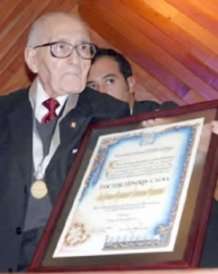Gabriel Vargas
Gabriel Bernal Vargas (5 February 1915 – 25 May 2010)[6][7] was a Mexican cartoonist, whose comic strip La Familia Burrón was created in 1937.[1][2][3] This cartoon has been described as one of the most important in Mexican popular culture.[6][7] Vargas won Mexico's "Premio Nacional de Periodismo" (National Journalism Prize) in 1983 and the "Premio Nacional de Ciencias y Artes en el área de Tradiciones Populares" (National Sciences and Arts Prize) in 2003.[1][2][6][7][8][9]
| Gabriel Vargas | |
|---|---|
 1983 "Premio Nacional de Periodismo" (National Journalism Prize) award ceremony | |
| Born | Gabriel Bernal Vargas February 5, 1915 Tulancingo, Hidalgo |
| Died | May 25, 2010 (aged 95) Mexico City |
| Nationality | Mexican |
| Area(s) | Cartoonist, painter[1][2][3][4][5] |
Notable works | La Familia Burrón (comic strip) The Burrón Family |
| Awards | 1983 "Premio Nacional de Periodismo" (National Journalism Prize) 2003 "Premio Nacional de Ciencias y Artes en el área de Tradiciones Populares" (National Sciences and Arts Prize)[6][7] |
Early life and education
Gabriel Vargas was born in Tulancingo, Hidalgo, on February 5, 1915, and had 11 siblings.[6][7] His father was a merchant and died when Gabriel was four years old.[1][2] In 1922, his mother, Josefina Bernal, moved the family to Mexico City.[1][2][6][7] Around 1928, Vargas began work as a draftsman for the Excélsior newspaper and eventually became its chief drawer[1][2][6][7] by 1931 when he was sixteen.[6][7] Vargas won an art contest sponsored by Panamericana Editorial which led to him penning his first comic, Los Superlocos, whose main protagonists became the basis for La Familia Burrón.[1][2][6][7]
La Familia Burrón
In 1937, Vargas began drawing La Familia Burrón as a separate piece which documented parents, Regino Burrón and Borola Tacuche de Burrón, their two teenage children, Regino and Macuca Burrón, and Foforito Cantarranas, a younger kid who was adopted by the Burróns.[1][2][6][7][8][10][11][12][13] La Familia Burrón profiled a lower class family's daily comedic struggles in an impoverished Mexican barrio.[8][10][11][12][13] At the height of its popularity, the comic strip helped circulation sales to reach 500,000 copies a week.[9][12][13] The comic was temporarily suspended but resumed in 1978.[12][13]
Later life and death
In 2007, Carlos Monsiváis, who is a patron of the arts, opened the Museo de El Estanquillo with an exhibition of Vargas' La Familia Burrón paintings with the artist in person.[4][5] The Burrón Family were represented in painted forms by Regino Burrón and Borola Tacuche de Burrón, Regino and Foforito.[4][5] Vargas sat paralyzed because of an affiction he had suffered for the past twenty years.[4][5]
The Consejo Nacional para la Cultura y las Artes stated Vargas died on 25 May 2010 at his Mexico City home.[6][7][8] His health had declined in recent years but no cause of death was given.[6][7][8] According to a statement released by this council, Vargas was "one of the greatest representatives of the golden age of Mexican comics" and an "undeniable reference point for the nation’s popular culture".[9]
Bibliography
The following is a list of Vargas' various comic strips:[1][2][6][7]
- Los Superlocos
- La Familia Burrón (1937–2009)
- La vida de Cristo
- Sherlock Holmes
- Pancho López
- El gran Caperuzo
- Los Chiflados
- Los del Doce
- Sopa de perico
Awards
In 1983, Vargas received the "Premio Nacional de Periodismo" (National Journalism Prize) in the field of Popular Traditions.[1][2][6][7] In 2003, the "Premio Nacional de Ciencias y Artes en el área de Tradiciones Populares" (National Sciences and Arts Prize) was presented to him.[1][2][6][7] In 2007, the Federal District government recognized Vargas as a Distinguished Citizen.[1][2][6][7] In addition, the Estanquillo Museum Collections exhibited many of his painted works as a homage.[6][7] At the time of his death, a complete exhibition of La Familia Burrón was on display at a museum in Florence, Italy.[1][2]
References
- "Muere el caricaturista Gabriel Vargas". El Universal (in Spanish). 25 May 2010. Retrieved 27 May 2010.
- "Muere el caricaturista Gabriel Vargas". El Universal. 25 May 2010. Retrieved 27 May 2010.
- "Mexican Cartoonist Gabriel Vargas Dies". Latin American Herald Tribune. Retrieved 28 May 2010.
- Amador, Judith (25 May 2010). "Fallece Gabriel Vargas, creador de La Familia Burrón". Proceso (in Spanish). proceso.com.mx. Archived from the original on 29 May 2010. Retrieved 28 May 2010.
- Amador, Judith (25 May 2010). "Fallece Gabriel Vargas, creador de La Familia Burrón". Proceso. Google Translate. Retrieved 28 May 2010.
- "Conaculta lamenta el fallecimiento del historietista mexicano Gabriel Vargas". Consejo Nacional para la Cultura y las Artes (in Spanish). conaculta.gob.mx. 26 May 2010. Retrieved 27 May 2010.
- "Conaculta lamenta el fallecimiento del historietista mexicano Gabriel Vargas". Consejo Nacional para la Cultura y las Artes. Google Translate. 26 May 2010. Retrieved 27 May 2010.
- "Gabriel Vargas, creator of Mexico's beloved 'La Familia Burron' comic strip, dies at 95". Fox News Channel. 25 May 2010. Retrieved 27 May 2010.
- Gardner, Alan (26 May 2010). "Mexico's Gabriel Vargas dies at age 95". The Daily Cartoonist. dailycartoonist.com. Retrieved 27 May 2010.
- "Caricaturas mexicanas: la familia Burrón". Globedia (in Spanish). mx.globedia.com. 28 September 2009. Retrieved 28 May 2010.
- "Caricaturas mexicanas: la familia Burrón". Globedia. Google Translate. September 28, 2009. Retrieved 28 May 2010.
- López-Portillo, Esther. "La Familia Burrón". Sepiensa.org.mx (in Spanish). sepiensa.org.mx. Archived from the original on 26 May 2010. Retrieved 28 May 2010.
- López-Portillo, Esther. "La Familia Burrón". Sepiensa.org.mx. Google Translate. Retrieved 28 May 2010.